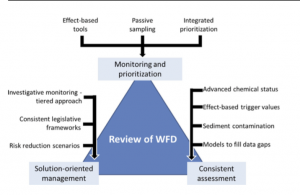In this post, Ralf B. Schäfer reports on a recent paper that he co-authored with a large consortium of European scientists.

Schematic overview of recommendations to improve water quality regulation (taken from the publication)
Water is a precious resource. The European Water Framework Directive (WFD), which came into power in 2000, requires all water bodies to reach a good ecological status, at latest by 2027. In addition, other European regulations aim at halting biodiversity loss, which is particularly high in freshwater ecosystems, and the Environment Action Programme to 2020 “Living Well, Within the Limits of Our Planet” aims at safeguarding a non-toxic environment. However, to date the majority of streams and rivers, for example almost 90% in Germany, fail to reach the good ecological status. Chemicals contribute to the failing of water bodies to reach a good ecological status and in the face of the review of the WFD in 2019, we critically assessed, how regulation with respect to chemicals could be improved. We provide 10 recommendations that can be classified broadly into recommendations to (1) improve monitoring and strengthen comprehensive prioritization, (2) foster consistent assessment and (3) support solution-oriented management. We believe that following these recommendations would be a major step forward to tackle the problem of chemical pollution and reach the goals of several European regulations. This could also serve as a role model for other regions of the world. If you are interested in how to translate the scientific state of the art into regulation, read the full paper here or download it from ResearchGate.
